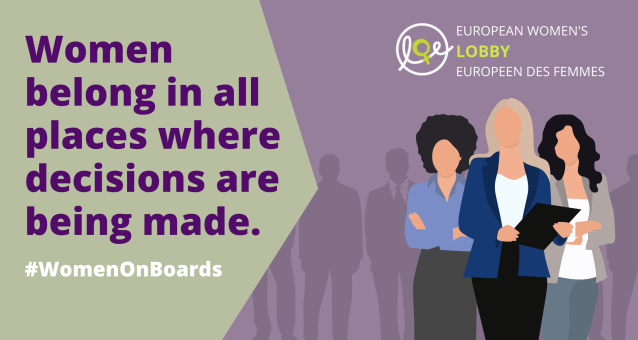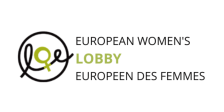Get on board with gender equality!
The EU Council adopts the Women on Boards Directive

On 17 October, the EU Council adopted the Women on Boards Directive, prompting listed companies to have at least 40% of board non-executive director positions or 33% of board executive and non-executive director positions held by the underrepresented sex. After 10 years of political and legislative blockade, this is a historic moment for women and girls, women leadership, women’s representation and their fundamental rights in the European Union. This significant step toward a Union of Equality will benefit all of us, including men and boys, by increasing skills, experiences and talent within companies’ leadership and fostering a more inclusive labour market.
Why is the Directive still significant 10 years after its first draft?
10 long years after the first draft of the Directive was issued by the European Commission, the EU Council finally adopted its definitive version on 17 October 2022. Yet, the adoption of the Directive on “improving the gender balance among directors of listed companies” seemed timely as it came shortly before the launch of the European Institute on Gender Equality’s (EIGE) 2022 Gender Index, whose data reminded all that the EU remains far from gender balance - let alone gender parity among large corporations’ decision-makers. While the proportion of women on the EU’s largest listed companies’ board reached 32% for the first time in April 2022, this proportion varies widely among the Member States: where Member States have implemented binding gender quotas, women make up to 37% of board members in the largest listed companies, while this proportion falls to 18% where no actions have been taken by Member States . Hence, the Directive is crucial to participate in addressing the current unequal representation of women and men on corporate boards. It also gives substance to the EU obligation to reach equality between women and men under the Lisbon Treaty (Art. 2, 3, 8) and under the Charter of Fundamental Rights.
What are the Directive’s provisions?
The Directive sets targets to be reached by 30 June 2026, applied to listed companies and to all board systems, ranging from dual systems to unitary systems. As per the Directive, these companies’ boards’ positions should be held by at least 40% of members from the underrepresented sex for non-executive director positions and 33% for both executive and non-executive director positions.
Critics of EU legislation on women’s representation on Boards tend to use the so-called merit principle against such initiatives. Nonetheless, it is crucial to reassert that there is a highly qualified pool of women whose opportunities to access the highest levels of economic decision-making have been denied - not for lack of expertise and skills but because of structural barriers including gender stereotypes. The reality is that with equal merit women do not compete on equal grounds with men when it comes to making it on boards or top management positions; it is high time to proactively address these inequalities. The Directive clarifies this point on multiple occasions, including by stating that appointment or election of the "best-qualified candidates” to executive and non-executive positions should be made on the “basis of a comparative assessment of the qualifications [...] by applying clear, neutrally formulated and unambiguous criteria established in advance of the selection process”, giving priority to “the equally qualified candidate of the underrepresented sex”.
Reporting, monitoring and review
The implementation of the Directive is monitored through a reporting process whereby listed companies have to communicate yearly, to a national authority of their choosing, on progress and measures taken to achieve the Directive’s objectives. This information should also be made available on companies’ websites and included in their annual report. Should a company fail to reach the objectives it should describe the concrete steps taken and future initiatives to achieve those. In addition, Member States have to report to the Commission every two years. This also applies to Member States benefitting from the suspension close. By the end of December 2030 and every two years after that, the European Commission should review the Directive’s application and report to the European Parliament and Council. The Directive should expire on 31 December 2038, unless the Commission assesses that the achievement of its objectives or their sustainability requires extension and/or amendment.
A soft incentive to penalties for non-compliance
Experience has shown that sanctions are crucial to the success of such legislation. Between 2011 and 2020 and the introduction of legislation with binding sanctions, the proportion of women on boards in France and Italy increased respectively by 23 percentage points and 32 percentage points. The Women on Boards Directive provides for “effective, proportionate and dissuasive” penalties for non-compliance, and spells out a few examples like fines or the annulment of a nomination. While the European Women’s Lobby (EWL) welcomes this inclusion and understands the need for flexibility at the national level, the EWL believes that keeping the provisions of the 2013 European Parliament text would have made the text stronger, spelling out “sanctions” rather than “penalities” and including exclusion from public calls for tenders, and partial exclusion from the award of funding from the Union’s Structural Funds.
Flexibility and the suspension clause
The unlocking of a 10-year deadlock partly rested on reassuring Member States and providing them with some flexibility. One of the ways to do that was by including a suspension clause whereby Member States that have already adopted similar legislation and fit certain conditions are exempt from complying with the provisions of Article 5(2) and Article 6 on the objectives and the means to achieve them. Hence, suspension can apply to Member States where members of the underrepresented sex hold at least 30% of the non-executive board director position or at least 25% of all board director positions in listed companies. The Member States can also use suspension if its national law sets the 30/25% targets; includes effective, proportional and dissuasive enforcement measures, and demands that listed companies not covered by that law set individual quantitative objectives. The EWL acknowledge the need for flexibility, however, it believes that as frontrunners, Member States that already have similar legislation should aim higher than their existing 30/25%, which remains insufficient to reach gender balance. Nonetheless, the Directive provides for an important safeguard by stating that if the objectives are no longer met by those Member States’, the provisions should apply no later than six months afterwards.
Scope to be widened
The EWL welcomes the removal of the provision under the EU Council General approach of 14 March 2022, which excluded from the Directive’s scope companies where the under-represented sex represents less than 10% of the employees. Not applying the Directive to companies from highly gender-segregated sectors would have been problematic and defeated its purpose.
However, the final version of the Women on Boards Directive does not apply to micro, small and medium-sized enterprises (SMEs), and only calls upon Member States to incentivise SMEs to adopt policies to improve gender balance at the management and board levels. This is a critical shortcoming, especially as the majority of women work in SMEs companies. It is of utmost importance that women’s expertise is capitalised upon at the highest level of decision-making and that their interests are represented, in all companies’ boards, including SMEs’.
“This Directive opens a door. A door to better companies, where the selection of decision-makers is based on competence and transparency and where the toxic features of internal corporate culture can also be addressed top-down. It is clear, however, that this has only opened the first and already very heavy door to these important issues. This means that more needs to be done to truly achieve a discrimination-free workplace and gender-balanced corporate boards. But we can already be proud of this first symbolic "foot in the door" with the Women on Boards Directive.” Vice-President Regner, co-rapporteur on the Women on Boards Directive
Room for improvement in the review phase
Valuable lessons should be learnt from Member States that have already implemented similar legislation. France is often taken as an example since it passed the Cope-Zimmermann law, which brought the proportion of women on listed companies’ boards from 10% (end of the 2000s) to 45% in 2021. The report from the Haut Conseil à l’Egalité entre les Femmes-Hommes (HCE) which took stock of a decade of implementation, emphasises that binding legislation, monitoring and reporting, and sanctions were critical in the legislation translating into significant progress. Yet, the report highlights that incentives such as compliance conditionality for the award of public tenders or fundings, should be introduce to go further.
“This 2011 law with the obligation of quotas of 20% first, then 40% for the least represented sex was a real revolution and a great success. Not only there were indeed competent women to employ, but also they brought more diverse professional backgrounds and experiences, and a greater diversity of perspectives to the boards. However, the arrival in large numbers of these women on boards of directors did not have the expected leverage effect in the executive and management bodies of companies, for which it was necessary to legislate ten years later.” Armelle Danet, La CLEF (French member organisation of the EWL)
The equal representation of women and men on corporate boards and in economic decision-making is essential for democracy and human rights. Boards approve major strategic and financial decisions and monitor the company’s management, having a widespread impact on the lives of women and men. Such decisions lack legitimacy when half of the European population is de-facto excluded from their deliberation and formulation. Hence, the EWL is pleased to see that the effort of EU Presidencies, Members of the European Parliament and the European Commission eventually led to the adoption of the Women on Boards Directive. This is a historic achievement and an encouraging first EU-wide step for the equal representation of women in decision-making positions.
Nonetheless, we strongly encourage European and national policy-makers to sustain their efforts and to go further when the Directive is reviewed. In particular, we call upon them to:
• To include all companies, including non-listed ones;
• To extend the scope of the Directive to SMEs;
• To provide for more ambitious and binding sanctions;
• To make Article 12 on suspension void as of 31 December 2030, which marks the first review of the Directive’s application by the EU; by that time, Member States benefitting from such suspension should have had ample time to progressively work towards the introduction of measures that would contribute to achieving the proportions set in Article 4 or even more ambitious targets.
Finally, the EWL also call upon decision-makers to ensure that women on boards are truly representative of the diversity of women, including women with disabilities, women from ethnic minorities, migrant women, lesbian women etc. The EWL also recalls that the success of a Directive like the Women on Board also depends on the policies adopted to tackle barriers to equal women’s representation such as gender norms, the care burden, gender pay, employment and pension gaps etc. That is why the EWL calls upon EU decision-makers to advance women’s rights in the ongoing work on the EU Care Strategy and the Pay Transparency Directive.
The next step, is for both the European Parliament’s JURI and FEMM Committees to adopt the final version of the text through a vote on 17 November. Then, the final formal step will take place with the European Parliament’s signing at the end of the month.
The EWL, with support from its members across the EU, will monitor the Directive’s national implementation and remains ready to support national and European policy-makers so that the transposition of this Directive results in significant advancement for women and society at large.




